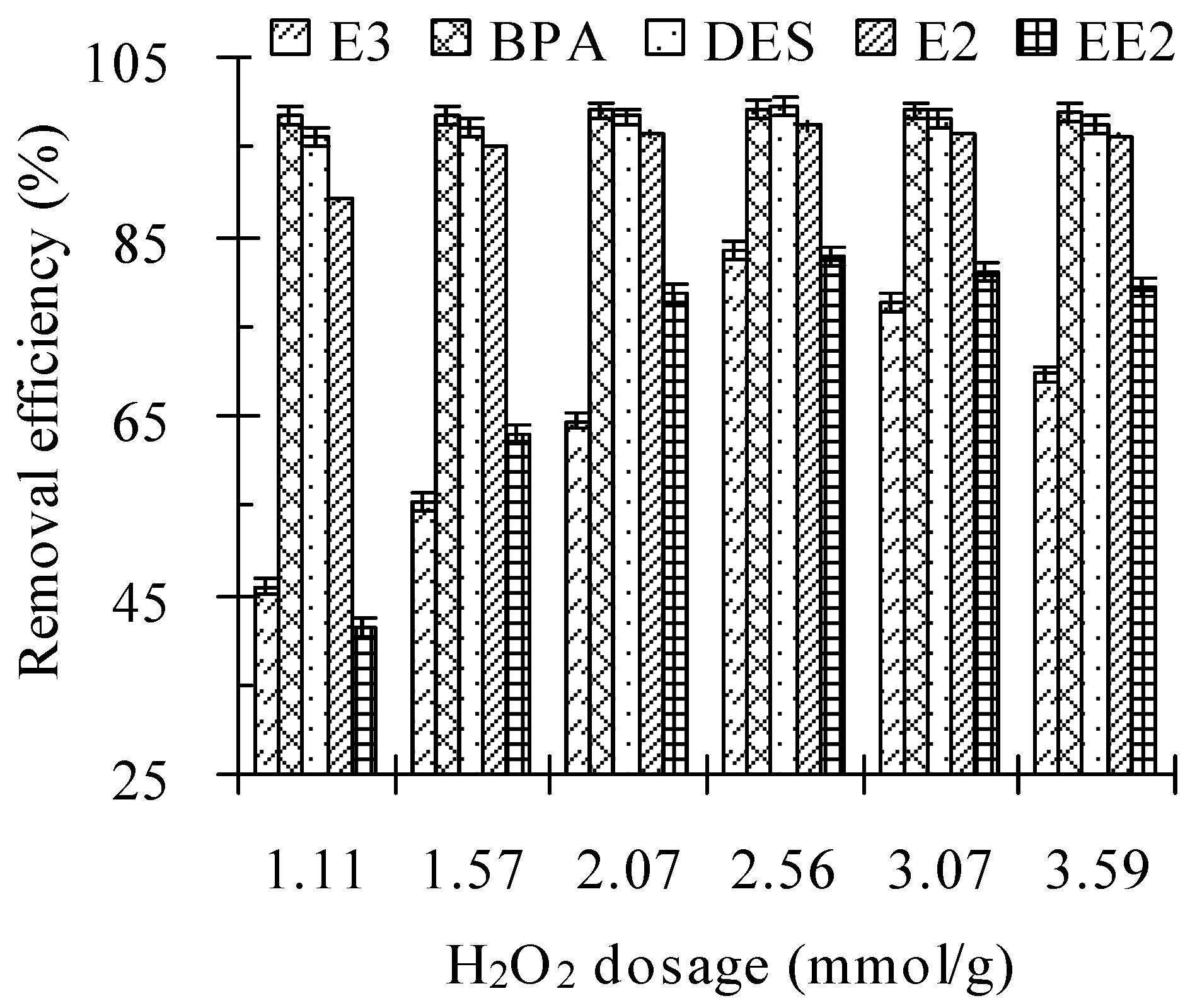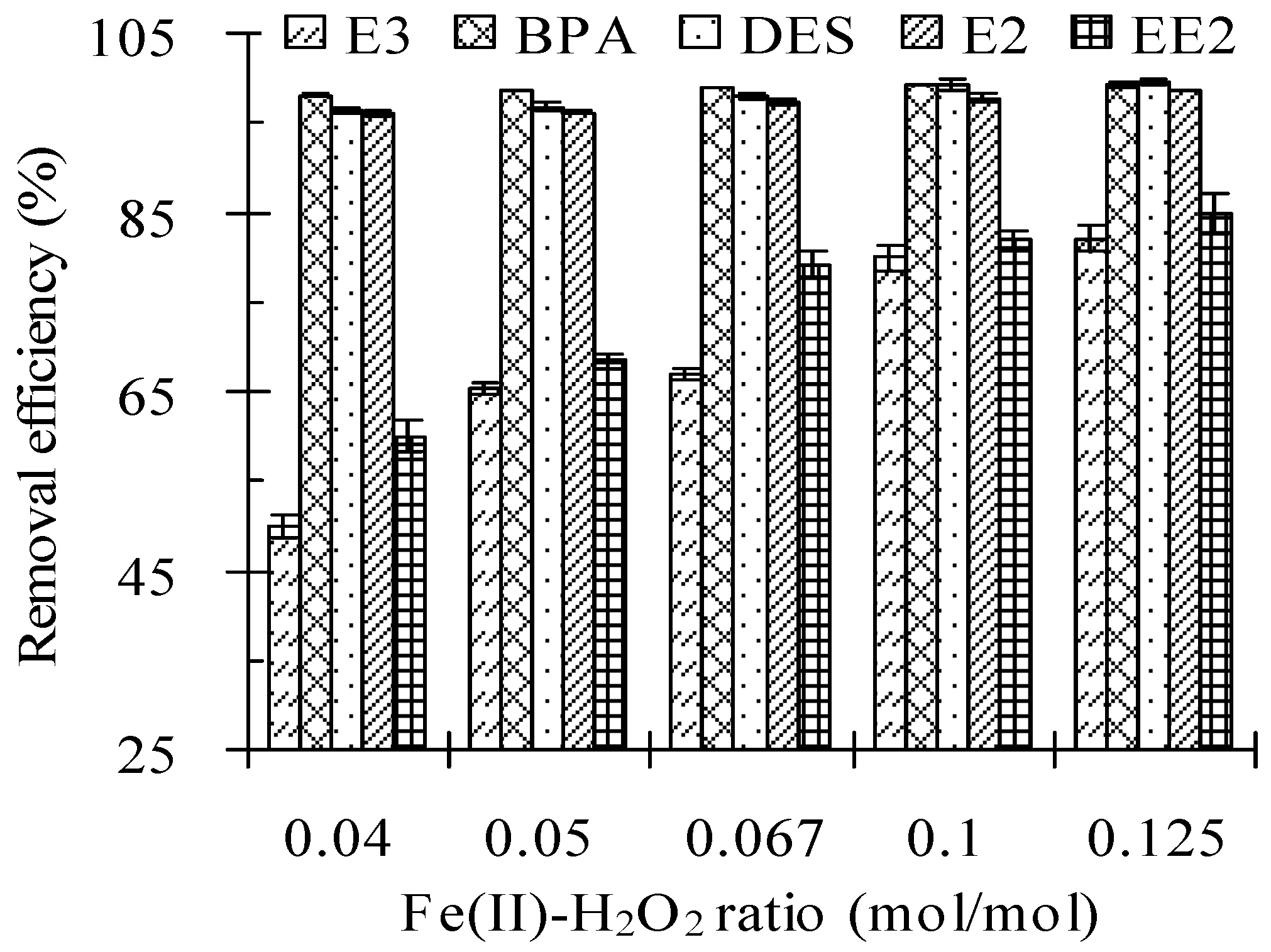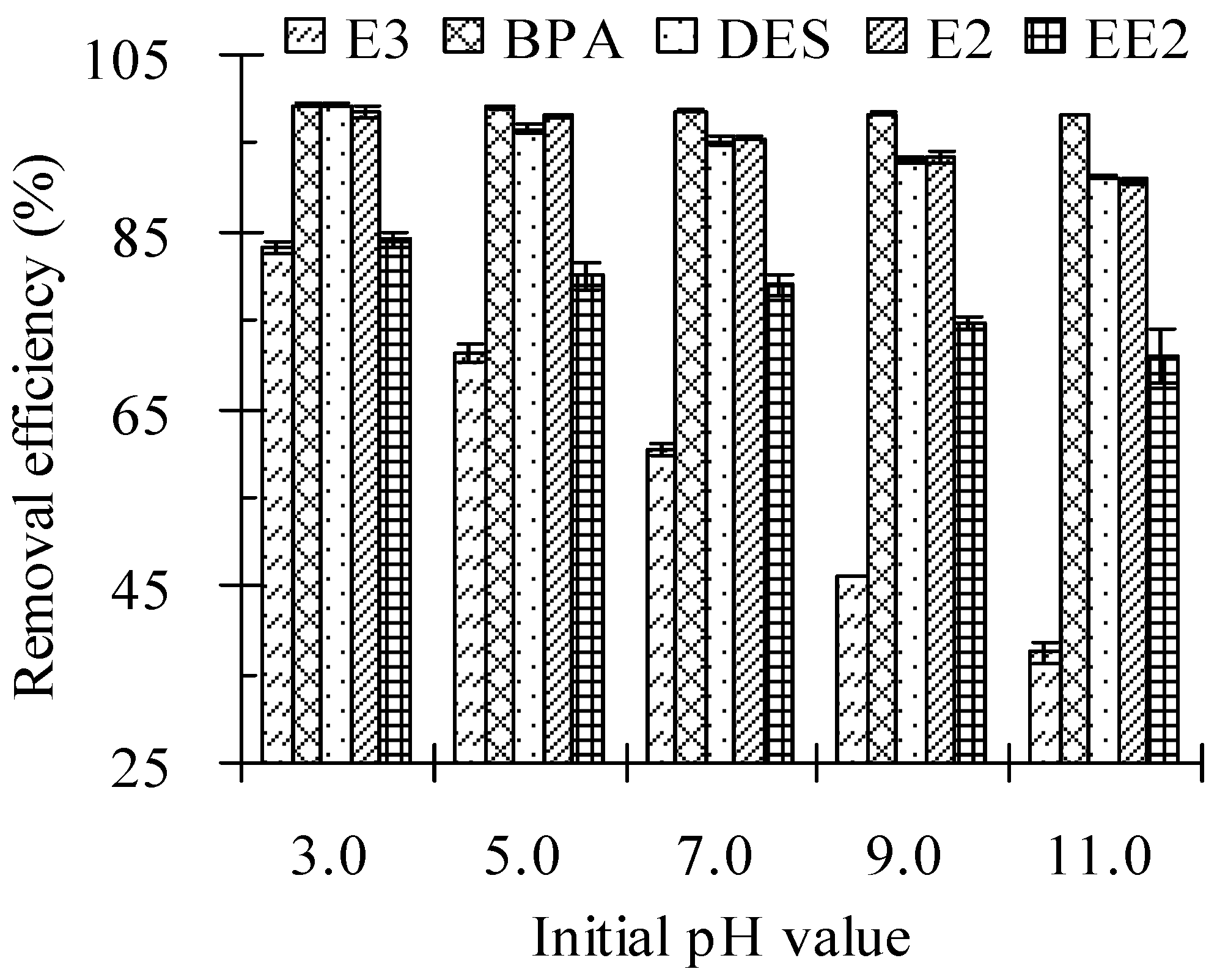Using Fenton Oxidation to Simultaneously Remove Different Estrogens from Cow Manure
Abstract
:1. Introduction
2. Materials and Methods
2.1. Chemicals
2.2. Cow Manure
2.2.1. Cow Manure Moisture Content
2.2.2. Preparation of Estrogen-Contaminated Cow Manure
2.3. Fenton Oxidation Experiments
2.4. Estrogen Analysis in Cow Manure
2.5. Statistical Analysis
3. Results
3.1. H2O2 Dosage
3.2. Fe(II) to H2O2 Molar Ratio
3.3. Solid to Water Mass Ratio
3.4. Initial pH Values
3.5. Reaction Time
4. Discussion
k1 ≈ 70 M−1·s−1
k2 = 0.01 M−1·s−1
k3 = 1.2 × 106 M−1·s−1 (at pH = 3)
k4 = 3.3 × 107 M−1·s−1
k5 ≈ 3.2 × 108 M−1·s−1
k6 = 1.3 × 106 M−1·s−1 (at pH = 3)
5. Conclusions
Acknowledgements
Author Contributions
Conflicts of Interest
References
- Auriol, M.; Filali-Meknassi, Y.; Tyagi, R.D.; Adams, C.D.; Surampalli, R.Y. Endocrine disrupting compounds removal from waste water: A new challenge. Process Biochem. 2006, 41, 525–539. [Google Scholar] [CrossRef]
- Lorenz, S. EU shifts endocrine disruptor research into overdrive. Science 2003, 300, 1069. [Google Scholar] [CrossRef] [PubMed]
- Fawell, J.K.; Young, W.F. Assessment of the human risk associated with the presence of carcinogenic compounds in drinking water. Ann. 1st Super Sanita 1993, 29, 313–316. [Google Scholar]
- Desbrow, C.; Routledge, E.J.; Brighty, G.C. Identification of estrogenic chemicals in STW effluent: 1 Chemical fractionation and in vitro biological screening. Environ. Sci. Technol. 1998, 32, 1549–1558. [Google Scholar] [CrossRef]
- Zheng, W.; Yates, S.R.; Bradford, S.A. Analysis of steroid hormones in a typical dairy waste disposal system. Environ. Sci. Technol. 2008, 42, 5277–5284. [Google Scholar] [CrossRef]
- Tashiro, Y.; Takemura, A.; Fujii, H. Livestock wastes as a source of estrogens and their effects on wild life of Manko tidal flat, Okinawa. Mar. Pollut. Bull. 2003, 47, 143–147. [Google Scholar] [CrossRef]
- Peterson, E.W.; Davis, R.K.; Orndorff, H.A. 17β-estradiol as an indicator of animal waste contamination in mantled karst aquifers. J. Environ. Qual. 2000, 29, 826–834. [Google Scholar] [CrossRef]
- Vader, J.S.; Van Ginkel, C.G.; Sperling, F.M.; De Jong, J.; De Boer, W.; De Graaf, J.S.; Van Der Most, M.; Stokman, P.G. Degradation of ethinyl estradiol by nitrifying activated sludge. Chemosphere 2000, 41, 1239–1243. [Google Scholar] [CrossRef]
- Tanaka, T.; Yamada, K.; Tonosaki, T.; Konishi, T.; Goto, H.; Taniguchi, M. Enzymatic degradation of alkylphenols, bisphenol A, synthetic estrogen and phthalic ester. Water Sci. Technol. 2000, 42, 89–95. [Google Scholar]
- Segmuller, B.E.; Armstrong, B.L.; Dunphy, R.; Oyler, A.R. Identification of autoxidation and photodegradation products of ethynylestradiol by on-line HPLC-NMR and HPLC-MS. J. Pharm. Biomed. Anal. 2000, 23, 927–937. [Google Scholar] [CrossRef]
- Coleman, H.M.; Eggins, B.R.; Byme, J.A.; Palmer, F.L.; King, E. Photocatalytic degradation of 17-β-estradiol on immobilized TiO2. Appl. Catal. B Environ. 2000, 24, L1–L5. [Google Scholar] [CrossRef]
- Yoshida, T.; Tanabe, T.; Miyashita, Y.; Yoshida, H.; Hattori, T. Degradation of dibutyl phthalate in water by the aid of metals under γ-ray irradiation. Chem. Lett. 2001, 9, 876–877. [Google Scholar] [CrossRef]
- Klavarioti, M.; Mantzavinos, D.; Kassinos, D. Removal of residual pharmaceuticals from aqueous systems by advanced oxidation processes. Environ. Int. 2009, 35, 402–417. [Google Scholar] [CrossRef] [PubMed]
- Caupos, E.; Mazellier, P.; Croue, J.P. Photodegradation of estrone enhanced by dissolved organic matter under simulated sunlight. Water Res. 2011, 45, 3341–3350. [Google Scholar] [CrossRef] [PubMed]
- Rosenfeldt, E.J.; Linden, K.G. Degradation of endocrine disrupting chemicals bisphenol A, ethinyl estradiol, and estradiol during UV photolysis and advanced oxidation processes. Environ. Sci. Technol. 2004, 38, 5476–5483. [Google Scholar] [CrossRef] [PubMed]
- Masomboon, N.; Ratanatamskul, C.; Lu, M. Kinetics of 2,6-dimethylaniline oxidation by various Fenton processes. J. Hazard. Mater. 2001, 192, 347–353. [Google Scholar] [CrossRef] [PubMed]
- Kuo, C.Y.; Lo, S.L. Oxidation of aqueous chlorobiphenyls with photo-fenton process. Chemosphere 1999, 38, 2041–2051. [Google Scholar]
- Ayoub, K.; Nelieu, S.; Van Hullebusch, E.D.; Maia-Grondard, A.; Cassir, M.; Bermond, A. TNT oxidation by Fenton reaction: Reagent ratio effect on kinetics and early stage degradation pathways. Chem. Eng. J. 2011, 173, 309–317. [Google Scholar] [CrossRef]
- Marco-Urrea, E.; Radjenović, J.; Caminal, G.; Petrović, M.; Vicent, T.; Barceló, D. Oxidation of atenolol, propranolol, carbamazepine and clofibric acid by a biological Fenton-like system mediated by the white-rot fungus Trametes versicolor. Water Res. 2010, 44, 521–532. [Google Scholar] [CrossRef]
- Zheng, H.; Pan, Y.; Xiang, X. Oxidation of acidic dye Eosin Y by the solar photo-Fenton processes. J. Hazard. Mater. 2007, 14, 457–464. [Google Scholar] [CrossRef] [PubMed]
- Wu, Y.; Zhou, S.; Zheng, K.; Ye, X.; Qin, F. Mathematical model analysis of Fenton oxidation of landfill leachate. Waste Manag. 2011, 31, 468–474. [Google Scholar] [CrossRef] [PubMed]
- Rigg, T.; Taylor, W.; Weiss, J. The rate constant of the reaction between hydrogen peroxide and ferrous ions. J. Chem. Phys. 1954, 22, 575–577. [Google Scholar] [CrossRef]
- Bielski, B.H.J.; Cabelli, D.E.; Arudi, R.L. Reactivity of H2O2/O2− radicals in aqueous solution. J. Phys. Chem. Ref. Data 1985, 14, 1041–1100. [Google Scholar] [CrossRef]
- Buxton, G.V.; Greenstock, C.L.; Helman, W.P.; Ross, A.B. Critical review of rate constants for reactions of hydrated electrons, hydrogen atoms and hydroxyl radicals (·OH/·O−) in aqueous solution. J. Phys. Chem. Ref. Data 1988, 17, 513–886. [Google Scholar] [CrossRef]
- Bouasla, C.; Samar, M.E.; Ismail, F. Degradation of methyl violet 6β dye by the Fenton process. Desalination 2010, 254, 35–41. [Google Scholar] [CrossRef]
- Mendez-Arriaga, F.; Esplugas, S.; Gimenez, J. Degradation of the emerging contaminant ibuprofen in water by photo-Fenton. Water Res. 2010, 44, 589–595. [Google Scholar] [CrossRef]
- Doku, G.N.; Verboom, W.; Reinhoudt, D.N.; Van Den Berg, A. On-microchip multiphase chemistry—A review of micro reactor design principles and reagent contacting modes. Tetrahedron 2005, 61, 2733–2742. [Google Scholar] [CrossRef]
- Zeronian, S.H.; Inglesby, M.K. Bleaching of cellulose by hydrogen peroxide. Cellulose 1995, 2, 265–272. [Google Scholar] [CrossRef]
- Neyens, E.; Baeyens, J. A review of classic Fenton’s per-oxidation as an advanced oxidation technique. J. Hazard. Mater. 2003, 98, 33–50. [Google Scholar] [CrossRef]
- Pérez, M.H.; Peñuela, G.; Maldonado, M.I. Degradation of pesticides in water using solar advanced oxidation processes. Appl. Catal. B Environ. 2006, 64, 272–281. [Google Scholar] [CrossRef]
- Darsinou, B.; Frontistis, Z.; Antonopoulou, M.; Konstantinou, I.; Mantzavinos, D. Sono-activated persulfate oxidation of bisphenol A: Kinetics, pathways and the controversial role of temperature. Chem. Eng. J. 2015, 280, 623–633. [Google Scholar] [CrossRef]
- Frontistis, Z.; Xekoukoulotakis, N.P.; Hapeshi, E.; Venieri, D.; Fatta-Kassinos, D.; Mantzavinos, D. Fast degradation of estrogen hormones in environmental matrices by photo-Fenton oxidation under simulated solar radiation. Chem. Eng. J. 2011, 178, 175–182. [Google Scholar] [CrossRef]





| Compound | E3 | BPA | DES | E2 | EE2 |
|---|---|---|---|---|---|
| Molecular structure |  |  |  |  |  |
| Molecular formula | C18H24O3 | C15H16O2 | C18H20O2 | C18H24O2 | C20H24O2 |
| Molar mass (g/M) | 288.4 | 228.3 | 268.36 | 272.38 | 296.4 |
| Melting point (°C) | 280~282 | 176~180 | 170~172 | 178~179 | 182~183 |
| Solubility in water (mg/L) | 13 | 13 | 10 | 1.51 ± 0.04 | 9.2 ± 0.09 |
| pKa | 10.4 | 10.7 | 10.3 | 10.5 | 11.3 |
| logKow | 2.6 | 3.94 | 5.07 | 3.1 | 3.9 |
| H2O2 Dosage/(mmol/g) | The Residual Concentrations of Estrogens in Cow Manure (mg/kg) | ||||
|---|---|---|---|---|---|
| E3 | BPA | DES | E2 | EE2 | |
| 0 | 97.40 ± 3.55 | 96.54 ± 0.42 | 100.22 ± 0.35 | 95.01 ± 1.01 | 72.49 ± 1.55 |
| 1.11 | 52.43 ± 1.60 | 1.21 ± 0.04 | 3.83 ± 0.13 | 9.96 ± 0.23 | 42.41 ± 2.76 |
| 1.57 | 43.28 ± 0.68 | 0.98 ± 0.03 | 2.81 ± 0.15 | 4.22 ± 0.07 | 26.54 ± 1.29 |
| 2.07 | 34.39 ± 2.16 | 0.58 ± 0.01 | 1.62 ± 0.18 | 3.06 ± 0.34 | 15.24 ± 1.81 |
| 2.56 | 15.92 ± 1.43 | 0.29 ± 0.03 | 0.48 ± 0.01 | 2.14 ± 0.44 | 12.11 ± 1.77 |
| 3.07 | 21.39 ± 3.77 | 0.57 ± 0.12 | 1.83 ± 0.08 | 3.03 ± 0.08 | 13.34 ± 1.55 |
| 3.59 | 29.35 ± 4.16 | 0.70 ± 0.04 | 2.36 ± 0.13 | 3.22 ± 0.21 | 14.60 ± 0.80 |
| Fe(II) to H2O2 Molar Ratio/(M/M) | The Residual Concentrations of Estrogens in Cow Manure (mg/kg) | ||||
|---|---|---|---|---|---|
| E3 | BPA | DES | E2 | EE2 | |
| 0 | 97.40 ± 3.55 | 96.54 ± 0.42 | 100.22 ± 0.35 | 95.01 ± 1.01 | 72.49 ± 1.55 |
| 0.04 | 47.63 ± 1.41 | 1.46 ± 0.29 | 3.60 ± 0.29 | 3.42 ± 0.09 | 26.83 ± 1.59 |
| 0.05 | 32.95 ± 1.46 | 0.94 ± 0.09 | 3.21 ± 0.71 | 3.25 ± 0.42 | 21.00 ± 0.71 |
| 0.067 | 31.37 ± 3.44 | 0.67 ± 0.09 | 2.01 ± 0.37 | 2.21 ± 0.28 | 13.81 ± 1.01 |
| 0.10 | 18.89 ± 4.84 | 0.33 ± 0.01 | 0.75 ± 0.44 | 1.72 ± 0.19 | 11.95 ± 0.31 |
| 0.125 | 16.82 ± 1.32 | 0.32 ± 0.02 | 0.48 ± 0.48 | 0.98 ± 0.40 | 9.92 ± 1.25 |
| Solid to Water Mass Ratio/(g/mL) | The Residual Concentrations of Estrogens in Cow Manure (mg/kg) | ||||
|---|---|---|---|---|---|
| E3 | BPA | DES | E2 | EE2 | |
| 2 | 19.56 ± 5.16 | 0.38 ± 0.11 | 0.54 ± 0.07 | 0.81 ± 0.14 | 11.12 ± 1.13 |
| 1 | 46.08 ± 2.09 | 0.77 ± 0.17 | 1.44 ± 0.19 | 2.85 ± 0.34 | 17.68 ± 0.90 |
| 0.5 | 61.28 ± 1.17 | 1.26 ± 0.08 | 2.47 ± 0.13 | 3.34 ± 0.59 | 20.47 ± 1.04 |
| 0.33 | 65.66 ± 4.28 | 2.05 ± 0.14 | 3.58 ± 0.11 | 4.54 ± 0.38 | 41.84 ± 4.78 |
| Initial pH Value | The Residual Concentrations of Estrogens in Cow Manure (mg/kg) | ||||
|---|---|---|---|---|---|
| E3 | BPA | DES | E2 | EE2 | |
| 3.0 | 15.57 ± 0.69 | 0.23 ± 0.09 | 0.62 ± 0.18 | 1.21 ± 0.72 | 11.51 ± 0.65 |
| 5.0 | 26.95 ± 0.90 | 0.54 ± 0.15 | 3.28 ± 0.51 | 1.72 ± 0.14 | 14.40 ± 1.14 |
| 7.0 | 38.56 ± 5.56 | 0.95 ± 0.11 | 4.69 ± 0.55 | 4.30 ± 0.15 | 15.71 ± 0.84 |
| 9.0 | 51.88 ± 7.22 | 1.22 ± 0.08 | 6.86 ± 0.22 | 6.65 ± 0.65 | 19.56 ± 0.57 |
| 11.0 | 61.74 ± 1.18 | 1.42 ± 0.04 | 8.78 ± 0.13 | 9.45 ± 0.30 | 22.90 ± 2.37 |
| Reaction Time/h | The Residual Concentrations of Estrogens in Cow Manure/(mg/kg) | ||||
|---|---|---|---|---|---|
| E3 | BPA | DES | E2 | EE2 | |
| 6 | 25.94 ± 0.52 | 1.16 ± 0.20 | 3.47 ± 0.31 | 6.21 ± 0.87 | 23.52 ± 1.57 |
| 12 | 22.18 ± 1.69 | 0.51 ± 0.19 | 2.53 ± 0.33 | 4.18 ± 0.87 | 15.38 ± 0.64 |
| 24 | 14.62 ± 4.59 | 0.11 ± 0.04 | 0.80 ± 0.40 | 1.95 ± 0.50 | 11.71 ± 2.32 |
| 36 | 16.09 ± 2.13 | 0.15 ± 0.04 | 0.75 ± 0.13 | 1.79 ± 0.08 | 9.59 ± 1.71 |
| 48 | 15.72 ± 1.61 | 0.08 ± 0.06 | 0.66 ± 0.25 | 1.70 ± 0.11 | 11.56 ± 4.30 |
| 72 | 14.76 ± 1.35 | 0.02 ± 0.00 | 0.70 ± 0.58 | 1.52 ± 0.69 | 10.36 ± 0.97 |
© 2016 by the authors; licensee MDPI, Basel, Switzerland. This article is an open access article distributed under the terms and conditions of the Creative Commons Attribution (CC-BY) license (http://creativecommons.org/licenses/by/4.0/).
Share and Cite
Sun, M.; Xu, D.; Ji, Y.; Liu, J.; Ling, W.; Li, S.; Chen, M. Using Fenton Oxidation to Simultaneously Remove Different Estrogens from Cow Manure. Int. J. Environ. Res. Public Health 2016, 13, 917. https://doi.org/10.3390/ijerph13090917
Sun M, Xu D, Ji Y, Liu J, Ling W, Li S, Chen M. Using Fenton Oxidation to Simultaneously Remove Different Estrogens from Cow Manure. International Journal of Environmental Research and Public Health. 2016; 13(9):917. https://doi.org/10.3390/ijerph13090917
Chicago/Turabian StyleSun, Minxia, Defu Xu, Yuefei Ji, Juan Liu, Wanting Ling, Shunyao Li, and Mindong Chen. 2016. "Using Fenton Oxidation to Simultaneously Remove Different Estrogens from Cow Manure" International Journal of Environmental Research and Public Health 13, no. 9: 917. https://doi.org/10.3390/ijerph13090917





